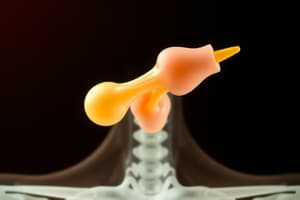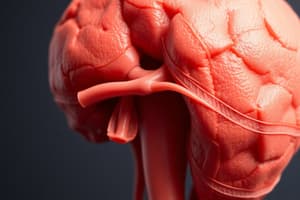Podcast
Questions and Answers
What are tropic hormones?
What are tropic hormones?
They are produced by the anterior pituitary gland and are hormones that control the activities of other endocrine glands.
Which hormones are secreted by the anterior pituitary?
Which hormones are secreted by the anterior pituitary?
FLAT PiG: FSH, LH, ACTH, TSH, PRL, GH
What hormones are secreted by the posterior pituitary?
What hormones are secreted by the posterior pituitary?
ADH and OT
What is another name for the anterior lobe of the pituitary gland?
What is another name for the anterior lobe of the pituitary gland?
What is another name for the posterior lobe of the pituitary gland?
What is another name for the posterior lobe of the pituitary gland?
What is FSH and its function?
What is FSH and its function?
What is LH and its function?
What is LH and its function?
What does ACTH do?
What does ACTH do?
What is TSH and its function?
What is TSH and its function?
What does PRL do?
What does PRL do?
What is GH and its function?
What is GH and its function?
What is ADH and its function?
What is ADH and its function?
What is OT and its function?
What is OT and its function?
What does simple squamous epithelium consist of?
What does simple squamous epithelium consist of?
What does simple cuboidal epithelium consist of?
What does simple cuboidal epithelium consist of?
What does simple columnar epithelium consist of?
What does simple columnar epithelium consist of?
What is ciliated pseudostratified columnar epithelium?
What is ciliated pseudostratified columnar epithelium?
What is keratinized stratified squamous epithelium?
What is keratinized stratified squamous epithelium?
What is non-keratinized stratified squamous epithelium?
What is non-keratinized stratified squamous epithelium?
What is stratified cuboidal epithelium?
What is stratified cuboidal epithelium?
What is transitional epithelium?
What is transitional epithelium?
What are the four main types of tissues?
What are the four main types of tissues?
What does the hypothalamus regulate?
What does the hypothalamus regulate?
What does ventral mean?
What does ventral mean?
What does dorsal mean?
What does dorsal mean?
What does anterior mean?
What does anterior mean?
What does posterior mean?
What does posterior mean?
What does cephalic mean?
What does cephalic mean?
What does superior mean?
What does superior mean?
What does inferior mean?
What does inferior mean?
What does proximal mean?
What does proximal mean?
What does distal mean?
What does distal mean?
What does ipsilateral mean?
What does ipsilateral mean?
What does contralateral mean?
What does contralateral mean?
What is gastrocnemius?
What is gastrocnemius?
What is cochlea?
What is cochlea?
What is a peripheral artery?
What is a peripheral artery?
Where on the tongue can you taste sweet sensation?
Where on the tongue can you taste sweet sensation?
What is infundibulum?
What is infundibulum?
What are the five types of white blood cells (WBCs)?
What are the five types of white blood cells (WBCs)?
What do neutrophils do?
What do neutrophils do?
What are eosinophils?
What are eosinophils?
What do basophils do?
What do basophils do?
What are lymphocytes?
What are lymphocytes?
What do monocytes do?
What do monocytes do?
What do B cells do?
What do B cells do?
What do T cells do?
What do T cells do?
What are platelets?
What are platelets?
What happens on the 14th day of the menstrual cycle?
What happens on the 14th day of the menstrual cycle?
What is spongy bone?
What is spongy bone?
What is compact bone?
What is compact bone?
What is axial skeleton?
What is axial skeleton?
How many bones are in the vertebral column?
How many bones are in the vertebral column?
How many bones are in cervical vertebrae?
How many bones are in cervical vertebrae?
How many bones are in thoracic vertebrae?
How many bones are in thoracic vertebrae?
How many bones are in lumbar vertebrae?
How many bones are in lumbar vertebrae?
What is appendicular skeleton?
What is appendicular skeleton?
What is the gallbladder?
What is the gallbladder?
What is the length of the menstrual cycle?
What is the length of the menstrual cycle?
What are the parts of quadriceps?
What are the parts of quadriceps?
Where is the trachea located?
Where is the trachea located?
In which artery do you take the pulse?
In which artery do you take the pulse?
What are the functions of the endoplasmic reticulum (ER)?
What are the functions of the endoplasmic reticulum (ER)?
Where do B-lymphocytes develop?
Where do B-lymphocytes develop?
Where do T-lymphocytes develop?
Where do T-lymphocytes develop?
Where is the damage to the ulnar nerve located?
Where is the damage to the ulnar nerve located?
What does ADH do in the nephrons?
What does ADH do in the nephrons?
What is the ventral cavity?
What is the ventral cavity?
What is the dorsal cavity?
What is the dorsal cavity?
What does the medulla oblongata do?
What does the medulla oblongata do?
What are hormones?
What are hormones?
What are flagella?
What are flagella?
What are cilia?
What are cilia?
What hormones do the ovaries produce?
What hormones do the ovaries produce?
What are nutrients?
What are nutrients?
Where is the calcaneal located?
Where is the calcaneal located?
Buttocks are dorsal.
Buttocks are dorsal.
What does the cerebrum aid in?
What does the cerebrum aid in?
What does the cerebellum aid in?
What does the cerebellum aid in?
Describe red blood cells.
Describe red blood cells.
What is the valve between the left atrium and left ventricle?
What is the valve between the left atrium and left ventricle?
What is the valve between the right atrium and right ventricle?
What is the valve between the right atrium and right ventricle?
What do villi do in the small intestine?
What do villi do in the small intestine?
What muscle draws a limb from the midline?
What muscle draws a limb from the midline?
What tastes are located on the side of the tongue?
What tastes are located on the side of the tongue?
What tastes are located on the tip of the tongue?
What tastes are located on the tip of the tongue?
What tastes are located at the back of the tongue?
What tastes are located at the back of the tongue?
What are the four steroid hormones?
What are the four steroid hormones?
What does estrogen do?
What does estrogen do?
What does progesterone do?
What does progesterone do?
What does aldosterone do?
What does aldosterone do?
What does cortisol do?
What does cortisol do?
What are protein hormones?
What are protein hormones?
What is protein synthesis?
What is protein synthesis?
What is Addison's disease?
What is Addison's disease?
What is renal artery?
What is renal artery?
What is the carotid body?
What is the carotid body?
What artery supplies blood to the kidney?
What artery supplies blood to the kidney?
What artery supplies blood to the liver?
What artery supplies blood to the liver?
Flashcards are hidden until you start studying
Study Notes
Tropic Hormones
- Tropic hormones are secreted by the anterior pituitary gland and influence other endocrine glands.
- The anterior pituitary releases FLAT PiG hormones: FSH, LH, ACTH, TSH, PRL, and GH.
- Posterior pituitary hormones include ADH (Antidiuretic Hormone) and OT (Oxytocin).
Pituitary Gland Structure
- Anterior lobe: adenohypophysis.
- Posterior lobe: neurohypophysis.
Hormone Functions
- FSH: Stimulates growth of ovarian follicles and sperm production.
- LH: Induces ovulation and testosterone secretion.
- ACTH: Stimulates adrenal cortex to release glucocorticoids.
- TSH: Stimulates the thyroid to secrete thyroid hormones.
- PRL: Promotes milk synthesis and increases sensitivity to LH in men.
- GH: Encourages growth of tissues.
Other Hormones
- ADH: Promotes water retention in kidneys, preventing dehydration.
- OT: Facilitates labor contractions, milk release, and bonding behaviors.
Epithelial Tissue Types
- Simple Squamous: Thin layer facilitating rapid diffusion and lubrication.
- Simple Cuboidal: Found in organs like the liver, involved in absorption and secretion.
- Simple Columnar: Tall cells lining stomach/uterus, responsible for absorption and mucus secretion.
- Ciliated Pseudostratified Columnar: Appears multilayered, secretes and propels mucus in the respiratory tract.
- Keratinized Stratified Squamous: Protects skin; resists abrasion.
- Non-Keratinized Stratified Squamous: Found in the tongue and vagina; resists abrasion and pathogen penetration.
- Stratified Cuboidal: In sweat gland ducts, involved in sweat and hormone secretion.
- Transitional Epithelium: Allows stretching in the urinary tract.
Body Systems and Terminology
- Four main tissue types: connective, nervous, epithelial, muscular.
- Hypothalamus regulates appetite, sleep, and thirst along with hormone secretion.
- Anatomical terms:
- Ventral: Front side of the body.
- Dorsal: Back side of the body.
- Anterior: Forward movement.
- Posterior: Backward movement.
- Superior: Above.
- Inferior: Below.
- Proximal: Closer to root attachment.
- Distal: Farther from root attachment.
- Ipsilateral: Same side of the body.
- Contralateral: Opposite side of the body.
Muscular and Skeletal Anatomy
- Gastrocnemius muscles, located in the back of the legs, flex the knee and ankle.
- Axial skeleton includes the skull, vertebral column, and thoracic cage.
- Appendicular skeleton consists of the pectoral girdle and limbs.
- Number of vertebrae: 26 in the column; includes 7 cervical, 12 thoracic, and 5 lumbar vertebrae.
- Compact bone has a dense, hard exterior; spongy bone contains red marrow and is located within bones.
Blood and Immune System
- Types of white blood cells: neutrophils, basophils, eosinophils, lymphocytes, and monocytes.
- Neutrophils phagocytize bacteria; eosinophils deal with parasites; basophils release histamine; lymphocytes are responsible for immune memory; monocytes develop into macrophages for pathogen clearance.
- B-cells produce antibodies; T-cells target and destroy infected cells.
- Platelets assist in blood clotting.
Additional Body Functions and Processes
- Menstrual cycle: LH surge on day 14 triggers ovulation.
- Gallbladder concentrates bile for fat digestion.
- Nutrients absorbed by small intestines are crucial for growth and maintenance.
- The cerebrum controls movement, memory, and sensory functions; the cerebellum coordinates motor function and timing.
Hormonal Regulation
- Ovaries produce estrogen and progesterone.
- Steroid hormones include estrogen, progesterone, testosterone, and cortisol.
- Addison's disease results from insufficient production of cortisol and aldosterone, leading to various symptoms.
Blood Circulation
- Renal artery supplies blood to the kidneys; hepatic artery supplies blood to the liver.
- Carotid body includes chemoreceptors that regulate heart and respiratory function.
Other Anatomical Considerations
- Infundibulum captures the egg during ovulation.
- Villi in the small intestine increase absorption surface area.
- Types of pulses can be taken from the carotid artery.
This structured overview provides essential details for study and review of tropic hormones, their functions, and related anatomical concepts.
Studying That Suits You
Use AI to generate personalized quizzes and flashcards to suit your learning preferences.




